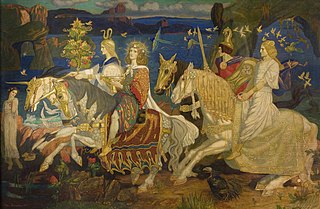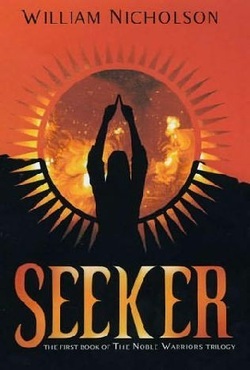
Irish mythology is the body of myths indigenous to the island of Ireland. It was originally passed down orally in the prehistoric era. In the early medieval era, some myths were transcribed by Christian monks, who heavily altered and Christianised the myths. Irish mythology is the best-preserved branch of Celtic mythology.

Mirza Shahab-ud-Din Muhammad Khurram, also known as Shah Jahan I, was the fifth Mughal emperor, reigning from 1628 until 1658. During his reign, the Mughals reached the peak of their architectural and cultural achievements.

The Taj Mahal is an ivory-white marble mausoleum on the right bank of the river Yamuna in Agra, Uttar Pradesh, India. It was commissioned in 1631 by the fifth Mughal emperor, Shah Jahan to house the tomb of his beloved wife, Mumtaz Mahal; it also houses the tomb of Shah Jahan himself. The tomb is the centrepiece of a 17-hectare (42-acre) complex, which includes a mosque and a guest house, and is set in formal gardens bounded on three sides by a crenellated wall.

In Irish mythology, Naisi, Noíse or Noisiu was the nephew of King Conchobar mac Nessa of Ulster, and a son of Uisneach. He is mentioned in the tale known as the Tragic Tale of the Sons of Uisnech, or Exiles of the Sons of Uisnech, usually found within the set of stories in the Táin Bó Cúailnge, part of the Ulster Cycle.

Red Cloud was a leader of the Oglala Lakota from 1865 to 1909. He was one of the most capable Native American opponents whom the United States Army faced in the western territories. He led the Lakota to defeat the United States during Red Cloud's War, establishing the Lakota as the only nation to defeat the United States on American soil. The largest action of the war was the 1866 Fetterman Fight, with 81 US soldiers killed; it was the worst military defeat suffered by the US Army on the Great Plains until the Battle of the Little Bighorn 10 years later.

The Shalimar Gardens are a Mughal garden complex located in Lahore, Punjab, Pakistan. The gardens date from the period when the Mughal Empire was at its artistic and aesthetic zenith, and are now one of Pakistan's most popular tourist destinations.

Crazy Horse was a Lakota war leader of the Oglala band in the 19th century. He took up arms against the United States federal government to fight against encroachment by White American settlers on Native American territory and to preserve the traditional way of life of the Lakota people. His participation in several famous battles of the Black Hills War on the northern Great Plains, among them the Fetterman Fight in 1866, in which he acted as a decoy, and the Battle of the Little Bighorn in 1876, in which he led a war party to victory, earned him great respect from both his enemies and his own people.

Mughal Gardens are a type of garden built by the Mughals. This style was influenced by the Persian gardens particularly the Charbagh structure, which is intended to create a representation of an earthly utopia in which humans co-exist in perfect harmony with all elements of nature.
William Benedict Nicholson, OBE, FRSL is a British screenwriter, playwright, and novelist who has been nominated twice for an Oscar.
In Irish mythology, Tír na nÓg or Tír na hÓige is one of the names for the Celtic Otherworld, or perhaps for a part of it. Tír na nÓg is best known from the tale of Oisín and Niamh.
Guardians of Ga'Hoole is a fantasy book series written by Kathryn Lasky and published by Scholastic. The series contains a total of 16 books and although originally intended to conclude with the 2008 publication of The War of the Ember, a prequel The Rise of a Legend was published in 2013. Apart from the main series there are a few more books and spin-offs set in the same universe. The first three books of the series were adapted into the animated 3D film Legend of the Guardians: The Owls of Ga'Hoole, directed by Zack Snyder.

The Last Unicorn is a fantasy novel by American author Peter S. Beagle and published in 1968, by Viking Press in the U.S. and The Bodley Head in the U.K. It follows the tale of a unicorn, who believes she is the last of her kind in the world and undertakes a quest to discover what has happened to the other unicorns. It has sold more than six million copies worldwide since its original publication, and has been translated into at least twenty-five languages.

Red Boy was a character featured in the 16th century novel Journey to the West. Red Boy was also known as the Boy Sage Great King and "Bull Boy Sage". Through this, Red Boy had developed True Samādhi Fire, which enables him to shoot fire inextinguishable by water and smoke from his eyes, nostrils and mouth. Samādhi is the Sanskrit word for concentration.
The Noble Warriors trilogy is a fantasy series, written by British novelist William Nicholson. The first book, Seeker, was published in 2006, as was the second in the trilogy, Jango. The third book, Noman, was published in September 2007.

Seeker (2005) is the first book in the Noble Warriors trilogy, written by William Nicholson.

Bengal is a fictional character appearing in American comic books published by Marvel Comics.
Harold, or the Norman Conquest is an opera in four acts with music by the British composer Frederic H. Cowen with a libretto by Edward Malet, edited by Frederic Edward Weatherly, adapted into the German by L.A. Caumont, and first performed at Covent Garden, London on 8 June 1895.

ElvenQuest is a comic fantasy broadcast on BBC Radio 4 by Anil Gupta and Richard Pinto, and starring Stephen Mangan, Alistair McGowan, Darren Boyd, Kevin Eldon, Sophie Winkleman and Dave Lamb. The series takes place in the world of Lower Earth, a parody of Middle-earth from The Lord of the Rings by J. R. R. Tolkien. In Lower Earth, a band of warriors go forth to search for a mythical sword to save Lower Earth from the evil Lord Darkness. In order to do so, they must find "The Chosen One" who will save Lower Earth. The Chosen One is Amis, a dog in the real world which belongs to a fantasy novelist called Sam Porter. The first series was broadcast from 29 March to 3 May 2009 and the second from 18 November to 23 December 2010. The third series was broadcast from 17 October to 21 November 2011. The fourth series was broadcast from 12 February to 19 March 2013.

Pul Kanjri is a historical site situated 35 km away from Amritsar on Amritsar-Lahore road, near the villages of Dhanoa Khurd and Dhanoa Kalan on the Wagah border. It is one of the heritage sites built by Maharaja Ranjit Singh, where he used to rest while travelling with his troops. During his reign, Pul Kanjari was an important trading centre. The legend has it when Maharaja Ranjit Singh married Begum Gul Bahar, on their way to Lahore they had to cross this canal on Ravi river. People used to cross the canal by foot but Begum Gul Bahar refused to do so. Since Maharaja Ranjit Singh was deeply in love with Begum Gul Bahar, he had a small bridge built for her. Some part of the bridge still exists. It was named Pul Kanjri. It was greatly in news during 1971 war. This fortress also contains a bathing pool, a temple, a Gurudwara and a mosque.
The Garden of Sinners: Paradox Spiral is a 2008 Japanese animated film produced by ufotable based on The Garden of Sinners novels by Kinoko Nasu. It is the fifth installment in the series, preceded by The Hollow Shrine (2008) and followed by Oblivion Recording (2008). Chronologically, the events that occur in The Garden of Sinners: Paradox Spiral are the sixth in the timeline of the series.













